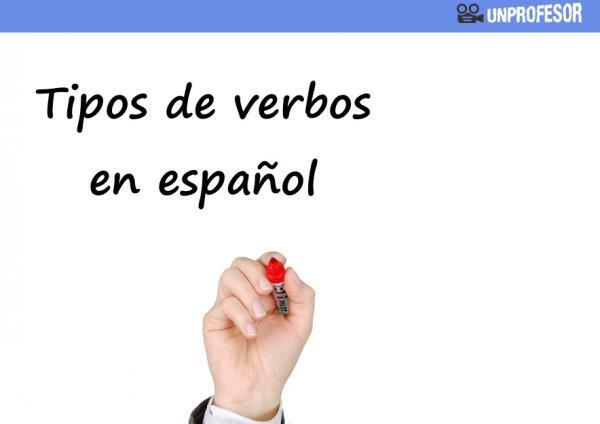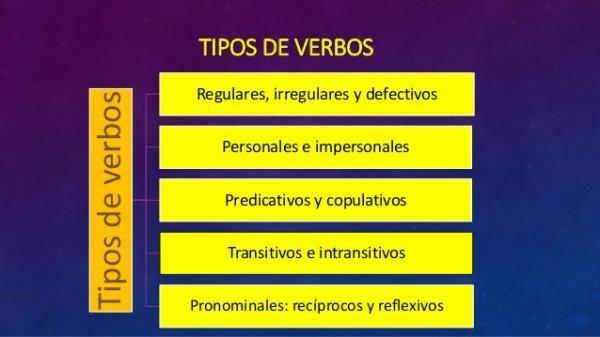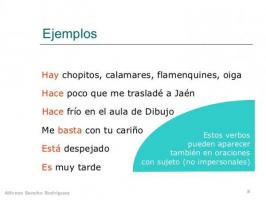Different TYPES of VERBS in Spanish

Verbs are a type of words that we use daily to communicate, without them it would not be possible to make sentences and therefore, correctly get a message from a sender to a receiver. In this lesson from a TEACHER we are going to show you the different types of verbs in Spanish. You will be able to know what they are and what classes exist to be able to apply them later in a correct way. In addition to learning to easily identify them, shall we start?
The verbsthey are words with a certain function. They are in charge of express a state, an achievement, an existence or an action. Its function within a sentence will always be the core of the predicate. That is, it will be the main part of this division of the sentence.
It shouldn't always go in a sentence, as verbs by themselves can create meaningful sentences without the need for a subject or complements. On the other hand, verbs are not static and present different functionalities of the actionThat is, they have a time, a mode, a number, a voice and a person. Let's see therefore some examples of verbs:
- Play
- I ran
- They will laugh
- You ate
- Would love
- Has snored

Image: Typesde.com
As we have already pointed out previously, verbs have different types in order to perform their functionality as the nucleus of the predicate in a sentence. Next we are going to point out what are the types of verbs that you can find in Spanish.
Copulative verbs
The copulative verbs They are one of the most popular types of verbs in Spanish. They are those who perform a Union between the subject, usually represented by a noun, and the predicate. These types of verbs do not serve to explain any action, but an existence. Thus we can point out that there are three copulative verbs:
- To be
- To be
- Seem
- Let's see an example of each of them below:
- Maria is tired.
- Alberto is very smart.
- This actor seems very good.
Predicative verbs
Predicative verbs are all those that serve to express an action. In order to simplify the concept, we can point out that the predicative verbs are all except the three copulatives that we have mentioned in the previous section. We are going to see a series of examples to be able to understand it better:
- Carmen always buys in the same store.
- I am very hungry.
- The dog goes for a walk every day.
Transitive verbs
Verbs transitive They are that need a direct complement to be able to function within a sentence. A transitive verb will always need this direct object to make the phrase have a full meaning. Let's see an example:
- Ana broke the chair.
- Miguel doesn't know how to cook.
Intransitive verbs
This type of verbs do not need a direct complement to give full meaning to the sentence. Although sometimes they can appear with them. These examples will help you understand what an intransitive verb is:
- The dog barks.
- Manuela studies.
It should be noted that the same verb can be transitive or intransitive. This will depend on how they are used in the sentence. We are going to use an example of the above. In the phrase Manuela studies, we can't find study What Intransitive verbHowever, if we add a direct object to it, the verb becomes transitive, leaving it as follows: Manuela studies Mathematics.
Reflexive verbs
These are also another of the types of verbs in Spanish that you have to know. In the reflexive verbs, the action of the verb falls on the subject of the same, that is to say, the subject will be the same that executes the action. To understand it better, we are going to see some examples:
- Manuel eats a sandwich.
- She combs.
- My mother leaves early.
Reciprocal verbs
These types of verbs are those whose action involves an exchange between different people or things. That is, there is an interaction between them, for example:
- We love each other
- You look at each other
Impersonal verbs
The impersonal verbs They are that they do not need a subject to have a complete meaning. They are always used in the infinitive or in the third person singular. They are usually used when we talk about meteorological phenomena or with any verb by introducing the pronoun se:
- Snows
- It rains
- He combs
Regular verbs
Regular verbs are one of the most common types of verbs in Spanish. Are the ones have a conjugation in which their stem remains unchanged. To make up the different verb tenses, it will only be necessary to add the necessary ending. Some examples are:
- Eat
- Sing
- Allow
- to love
Irregular verbs
The irregular verbs, when conjugating them and adding the relevant endings, these types of verbs will modify your root. It does not happen in all times or modes, only in some. Although there are not many, we are going to show you some examples of irregular verbs.
To fit: It transforms in fit in the first person singular of the Present Indicative, but nevertheless it remains as fits in the third person singular of the Present Indicative.
We hope that you have been able to clarify your doubts about types of verbs in Spanish and that you continue to increase your knowledge with our articles on Spanish language.

Image: Comparison Chart



